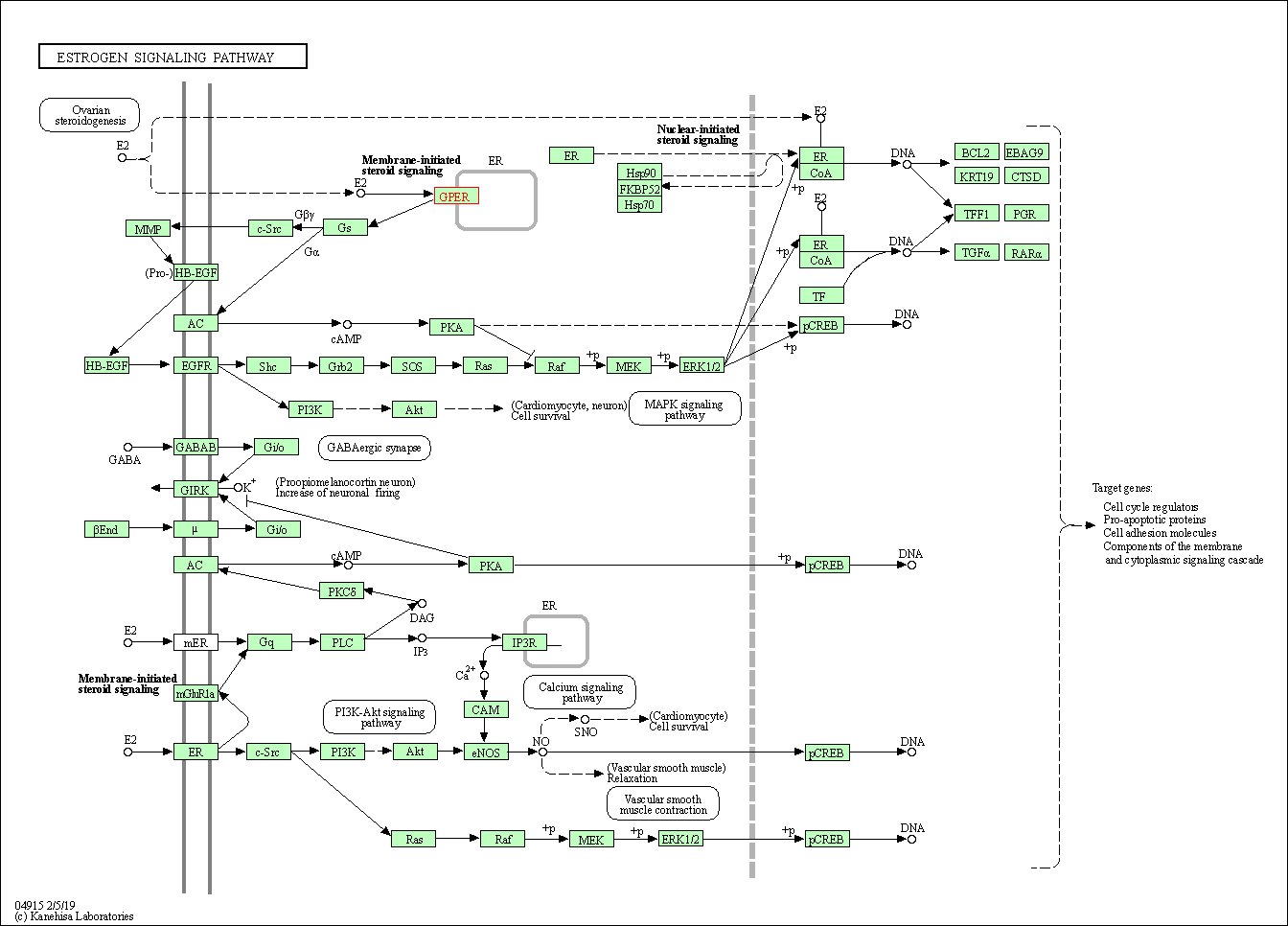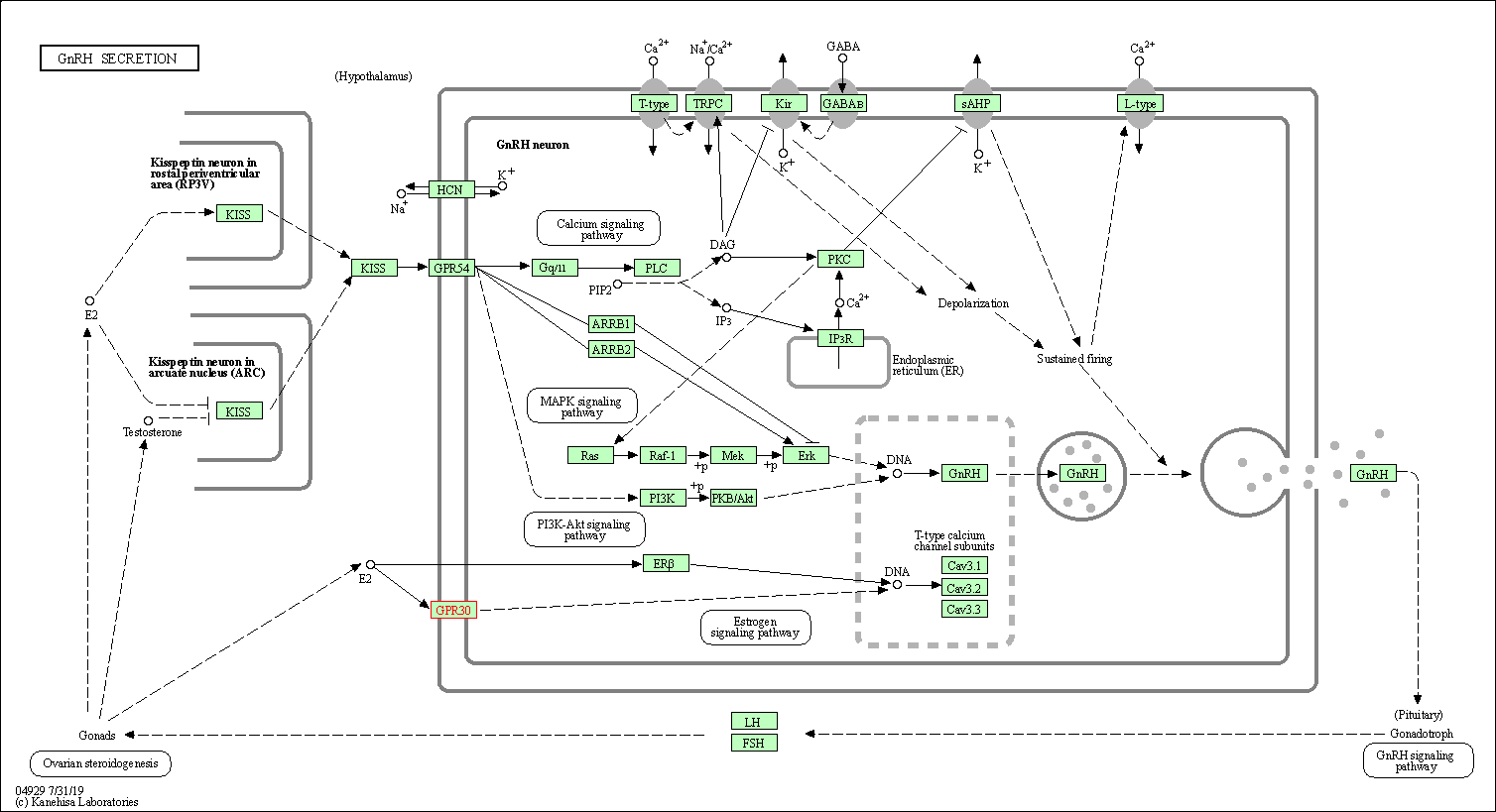Target Information
| Target General Information | Top | |||||
|---|---|---|---|---|---|---|
| Target ID |
T65236
(Former ID: TTDNR00682)
|
|||||
| Target Name |
G-protein coupled estrogen receptor 1 (GPER1)
|
|||||
| Synonyms |
Membrane estrogen receptor; Lymphocyte-derived G-protein coupled receptor; LYGPR; IL8-related receptor DRY12; GPER1; GPER; GPCR-BR; G-protein coupled receptor 30; Flow-induced endothelial G-protein coupled receptor 1; FEG-1; Chemoattractant receptor-like 2
Click to Show/Hide
|
|||||
| Gene Name |
GPER1
|
|||||
| Target Type |
Successful target
|
[1] | ||||
| Disease | [+] 1 Target-related Diseases | + | ||||
| 1 | Contraceptive management [ICD-11: QA21] | |||||
| Function |
Receptor for estrogen. .
Click to Show/Hide
|
|||||
| BioChemical Class |
GPCR rhodopsin
|
|||||
| UniProt ID | ||||||
| Sequence |
MDVTSQARGVGLEMYPGTAQPAAPNTTSPELNLSHPLLGTALANGTGELSEHQQYVIGLF
LSCLYTIFLFPIGFVGNILILVVNISFREKMTIPDLYFINLAVADLILVADSLIEVFNLH ERYYDIAVLCTFMSLFLQVNMYSSVFFLTWMSFDRYIALARAMRCSLFRTKHHARLSCGL IWMASVSATLVPFTAVHLQHTDEACFCFADVREVQWLEVTLGFIVPFAIIGLCYSLIVRV LVRAHRHRGLRPRRQKALRMILAVVLVFFVCWLPENVFISVHLLQRTQPGAAPCKQSFRH AHPLTGHIVNLAAFSNSCLNPLIYSFLGETFRDKLRLYIEQKTNLPALNRFCHAALKAVI PDSTEQSDVRFSSAV Click to Show/Hide
|
|||||
| 3D Structure | Click to Show 3D Structure of This Target | AlphaFold | ||||
| HIT2.0 ID | T32YAJ ; T35XJB | |||||
| Drugs and Modes of Action | Top | |||||
|---|---|---|---|---|---|---|
| Approved Drug(s) | [+] 1 Approved Drugs | + | ||||
| 1 | Segesterone acetate; ethinyl estradiol | Drug Info | Approved | Contraception | [1] | |
| Clinical Trial Drug(s) | [+] 1 Clinical Trial Drugs | + | ||||
| 1 | G1 | Drug Info | Phase 1/2 | Lymphoma | [2] | |
| Mode of Action | [+] 3 Modes of Action | + | ||||
| Modulator | [+] 1 Modulator drugs | + | ||||
| 1 | Segesterone acetate; ethinyl estradiol | Drug Info | [1] | |||
| Agonist | [+] 1 Agonist drugs | + | ||||
| 1 | G1 | Drug Info | [3] | |||
| Antagonist | [+] 2 Antagonist drugs | + | ||||
| 1 | G15 | Drug Info | [4] | |||
| 2 | G36 | Drug Info | [5] | |||
| Cell-based Target Expression Variations | Top | |||||
|---|---|---|---|---|---|---|
| Cell-based Target Expression Variations | ||||||
| Different Human System Profiles of Target | Top |
|---|---|
|
Human Similarity Proteins
of target is determined by comparing the sequence similarity of all human proteins with the target based on BLAST. The similarity proteins for a target are defined as the proteins with E-value < 0.005 and outside the protein families of the target.
A target that has fewer human similarity proteins outside its family is commonly regarded to possess a greater capacity to avoid undesired interactions and thus increase the possibility of finding successful drugs
(Brief Bioinform, 21: 649-662, 2020).
Human Pathway Affiliation
of target is determined by the life-essential pathways provided on KEGG database. The target-affiliated pathways were defined based on the following two criteria (a) the pathways of the studied target should be life-essential for both healthy individuals and patients, and (b) the studied target should occupy an upstream position in the pathways and therefore had the ability to regulate biological function.
Targets involved in a fewer pathways have greater likelihood to be successfully developed, while those associated with more human pathways increase the chance of undesirable interferences with other human processes
(Pharmacol Rev, 58: 259-279, 2006).
Biological Network Descriptors
of target is determined based on a human protein-protein interactions (PPI) network consisting of 9,309 proteins and 52,713 PPIs, which were with a high confidence score of ≥ 0.95 collected from STRING database.
The network properties of targets based on protein-protein interactions (PPIs) have been widely adopted for the assessment of target’s druggability. Proteins with high node degree tend to have a high impact on network function through multiple interactions, while proteins with high betweenness centrality are regarded to be central for communication in interaction networks and regulate the flow of signaling information
(Front Pharmacol, 9, 1245, 2018;
Curr Opin Struct Biol. 44:134-142, 2017).
Human Similarity Proteins
Human Pathway Affiliation
Biological Network Descriptors
|
|
| KEGG Pathway | Pathway ID | Affiliated Target | Pathway Map |
|---|---|---|---|
| Estrogen signaling pathway | hsa04915 | Affiliated Target |

|
| Class: Organismal Systems => Endocrine system | Pathway Hierarchy | ||
| GnRH secretion | hsa04929 | Affiliated Target |

|
| Class: Organismal Systems => Endocrine system | Pathway Hierarchy | ||
| Degree | 2 | Degree centrality | 2.15E-04 | Betweenness centrality | 2.41E-05 |
|---|---|---|---|---|---|
| Closeness centrality | 2.22E-01 | Radiality | 1.39E+01 | Clustering coefficient | 0.00E+00 |
| Neighborhood connectivity | 8.55E+01 | Topological coefficient | 5.12E-01 | Eccentricity | 12 |
| Download | Click to Download the Full PPI Network of This Target | ||||
| Chemical Structure based Activity Landscape of Target | Top |
|---|---|
| Drug Property Profile of Target | Top | |
|---|---|---|
| (1) Molecular Weight (mw) based Drug Clustering | (2) Octanol/Water Partition Coefficient (xlogp) based Drug Clustering | |
|
|
||
| (3) Hydrogen Bond Donor Count (hbonddonor) based Drug Clustering | (4) Hydrogen Bond Acceptor Count (hbondacc) based Drug Clustering | |
|
|
||
| (5) Rotatable Bond Count (rotbonds) based Drug Clustering | (6) Topological Polar Surface Area (polararea) based Drug Clustering | |
|
|
||
| "RO5" indicates the cutoff set by lipinski's rule of five; "D123AB" colored in GREEN denotes the no violation of any cutoff in lipinski's rule of five; "D123AB" colored in PURPLE refers to the violation of only one cutoff in lipinski's rule of five; "D123AB" colored in BLACK represents the violation of more than one cutoffs in lipinski's rule of five | ||
| Target Affiliated Biological Pathways | Top | |||||
|---|---|---|---|---|---|---|
| Reactome | [+] 2 Reactome Pathways | + | ||||
| 1 | Peptide ligand-binding receptors | |||||
| 2 | G alpha (i) signalling events | |||||
| WikiPathways | [+] 3 WikiPathways | + | ||||
| 1 | GPCRs, Class A Rhodopsin-like | |||||
| 2 | GPCR ligand binding | |||||
| 3 | GPCR downstream signaling | |||||
| References | Top | |||||
|---|---|---|---|---|---|---|
| REF 1 | 2018 FDA drug approvals.Nat Rev Drug Discov. 2019 Feb;18(2):85-89. | |||||
| REF 2 | ClinicalTrials.gov (NCT04130516) Phase 1 Study to Determine the MTD, Safety, Tolerability, PK and Preliminary Anti-tumor Effects of LNS8801alone and in Combination With Pembrolizumab. U.S. National Institutes of Health. | |||||
| REF 3 | Virtual and biomolecular screening converge on a selective agonist for GPR30. Nat Chem Biol. 2006 Apr;2(4):207-12. | |||||
| REF 4 | In vivo effects of a GPR30 antagonist. Nat Chem Biol. 2009 Jun;5(6):421-7. | |||||
| REF 5 | Identification of a GPER/GPR30 antagonist with improved estrogen receptor counterselectivity. J Steroid Biochem Mol Biol. 2011 Nov;127(3-5):358-66. | |||||
If You Find Any Error in Data or Bug in Web Service, Please Kindly Report It to Dr. Zhou and Dr. Zhang.

